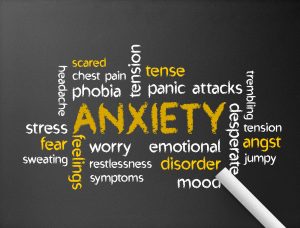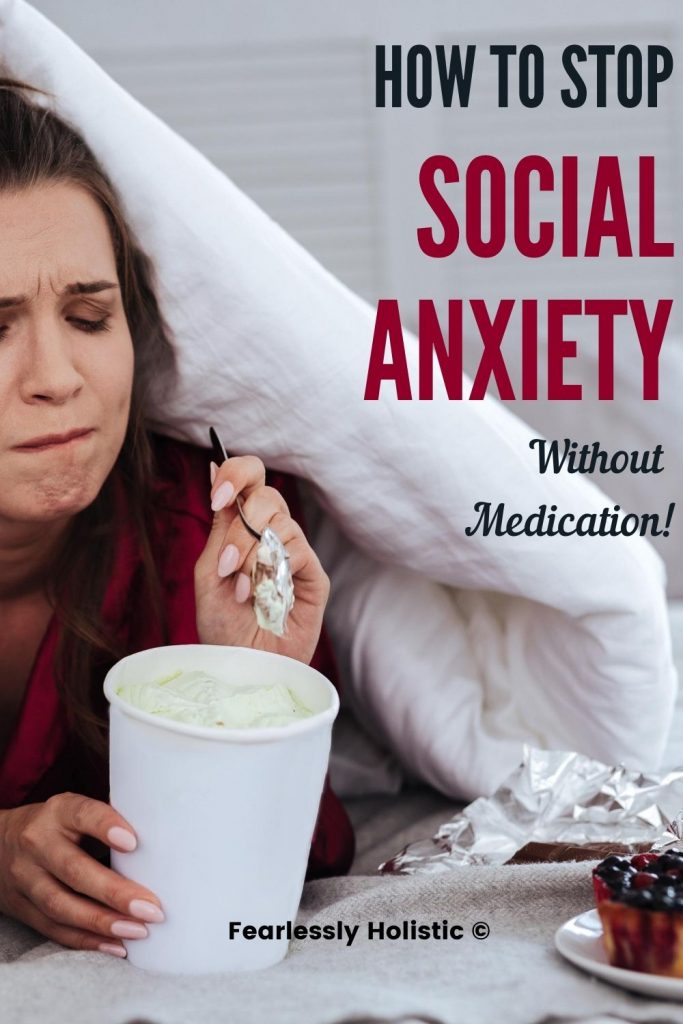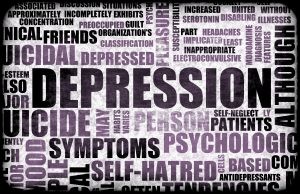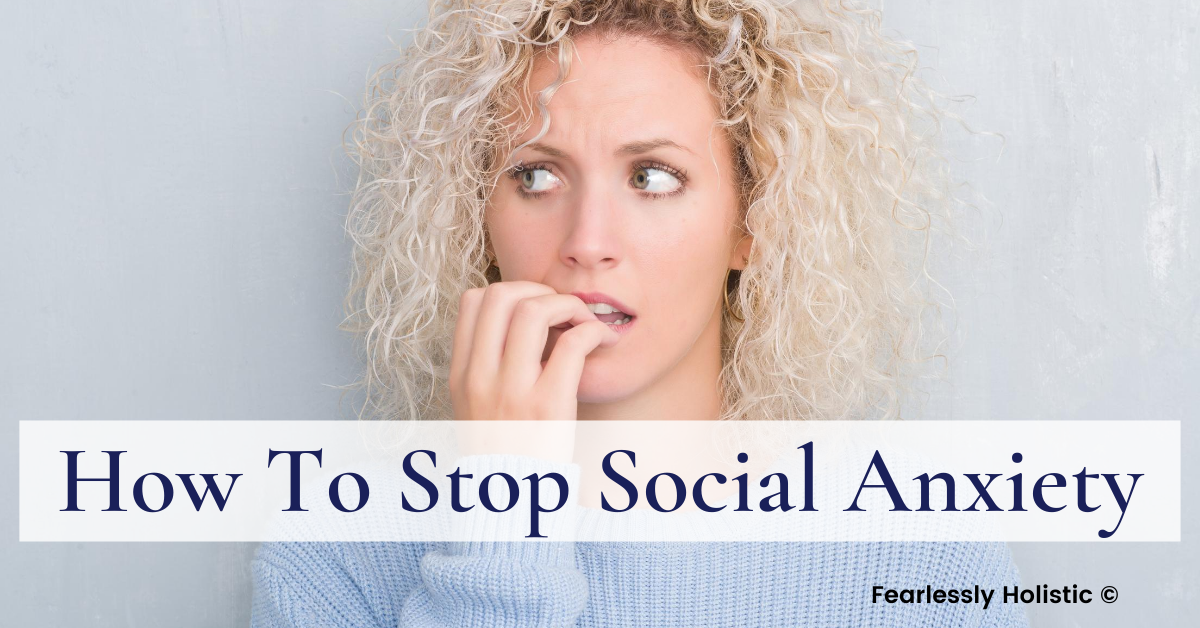Is social anxiety a real thing? Just ask any teenager in middle or high school. Not only is social anxiety real, it is also crippling to some people, like me.
But why? What is social anxiety? Why are people afraid of other people? Are humans not meant to be “social”?
Social anxiety disorder affects millions of people around the world and varies greatly from person to person. However, it is important to know that if you find social settings unbearable, you can get help.
Hello and welcome to Fearlessly Holistic
My name is Irma and I want to share my journey to improved health by eating whole foods, moving my body and eliminating stress as much as possible.
It is my hope to inspire you to make daily changes.
Why? Because eating fresh, seasonal food and getting some sunshine is the best way to increase longevity. But you do not want just a long life.
You want a quality long life.
My blog posts are my opinion and the results of things that I have tried that either worked for me or didn’t. My opinions are for informational purposes only and are not intended as medical advice. Medical advice should always be obtained from a qualified medical professional for any health conditions or symptoms associated with them. As well, there may be affiliate links in this post. Read more here.
Is Anxiety Normal?

Yes. It’s perfectly normal to feel anxious or depressed occasionally, especially in response to life’s stressors.
Anxiety and depression seem to go hand-in-hand. When two health issues are present at the same time, it is called comorbidity.
Anxiety is meant to give our body the speed and agility to escape danger a.k.a flight or fright.
It’s meant to save our lives. It’s natural.
These days our stressors are bad drivers, crazy work deadlines, and kids with multiple extra-curriculars.
But our body still responds to stress as if we are being chased by a wild animal.
When anxiety becomes prolonged, disproportionate or apparent for no significant reason, it needs to be addressed.
What many of us have not learned is how to cope with daily stress while maintaining our mental health.
Thankfully diagnosis and treatment methods have come a long way. The co-occurrence of anxiety and depression is a noted feature of these disorders.
While behavioral and emotional symptoms may differ within the two, the fact remains they are both an unnatural and unwelcome state of mental health.
Anxiety is characterized by “a constant overwhelming state of fear or worry”.
The symptoms of depression may be similar with unrelenting feelings of sadness or despair.
Related Post: Do I Have Depression? Depression Explained
The exact cause is still unclear; however, changes in brain chemistry, genetic factors, and hormone function are all believed to play a role.
Irrespective of the cause, mental illness requires and generally responds to treatment.
Doctors treat anxiety with anti-depressant drugs. However some medications used for depression can mask other mental health issues. In my case, they masked a developing panic disorder.
And some medications for anxiety can make the symptoms worse.
That is the nature of prescription drugs made for everyone…everyone is not the same.
Which is why if your medication is not working for you, your doctor will have a list of multiple other medications for you to try.
This is an obvious hint that physicians know very little about alternative help for anxiety. They can point you to your local mental health association and that’s about it.
When I stopped anti-depressants, I soon gained anxiety. And later on, panic.
I’ve always had low level social anxiety aka shyness. But never before did I have panic disorder.
It’s a bummer to successfully wean off one drug only to get another issue that every doctor wants to treat with…guess what? More prescription drugs.
However if you want to deal with your mental health issues naturally, you need to know exactly what your issues are without drugs.
*PLEASE DO NOT STOP TAKING PRESCRIPTION MEDICATION WITHOUT THE ASSISTANCE OF A DOCTOR*
If you are taking multiple drugs for multiple mental health issues, you must use a process to wean off of the drugs. You can make your life worse by going “cold turkey”.
It is very important to have help when cutting back prescription drugs, especially the kind that affect your brain. Withdrawl symptoms can include:
- Anxiety
- Panic Attacks
- Extreme Agitation
- Insomnia or vivid dreams
- Headaches
- Hostility
- Nausea
- Flu-like symptoms
- Tiredness
- Dizziness
Many prescription drugs make some anxiety symptoms worse. That seems especially true of drugs that treat mental health.
Some medications contain questionable ingredients which can react with other medications, prescription or otherwise.
Doctors have a good understanding of how long it will take for you to wean off, based on how much you currently take and with which other drugs.
There is no one-size-fits-all solution to treating any health issue.
Do yourself a favor and look at the kinds of medications you take and why. Seek out non-drug solutions to start implementing.
You can increase the non-drug solutions while weaning off of some prescription drugs.
Please use care and caution.Wean off only one medication at a time unless your doctor says otherwise.
Strive to keep balance, especially when trying new things or eliminating things that don’t help your life.

What is Social Anxiety Disorder?
Do you have intense feelings of discomfort and fear when in social situations?
You may have social anxiety disorder.
Check out the video below to see if your symptoms are really social anxiety:
Common signs that you may have this disorder include a number of fears, mostly related to social events and being with strangers.
Some common fears that people with social anxiety have are:
- That everyone is focusing on you
- You think that you are constantly making mistakes
- Assuming that everyone is judging you
- Feeling that everyone is better than you
- You’re afraid of humiliating yourself
- Afraid that everyone sees your flaws
These fears may or may not cause panic attacks, but always cause intense anxiety.
Physical symptoms of anxiety are:
- Trembling
- Dizziness/lightheadedness
- Fast heartbeat (tachycardia)
- Blushing
- Sweating
- Muscle tension
- Mind goes blank
- Nausea
- Feeling like you have trouble catching your breath.
I once volunteered to go on stage for a Christmas program and I am pretty sure that I had all of the above symptoms…maybe more. I know that I was still anxious days later… #stopsayingyestoplays
I do not know how or when I developed anxiety and panic. But when I stopped taking anti-depressants, within 3 months I had both.
And while I have always been somewhat shy and introverted, I also now had full-on social anxiety.
Shyness is not the same as social anxiety disorder.
While you may feel shy in certain situations, social anxiety disorder is physically debilitating to a person experiencing it. In fact, social anxiety disorder may take over a person’s life if left untreated.
This disorder usually starts from childhood or early adulthood and can affect everyone, regardless of race, religion, or gender.
Women are more likely to develop this disorder than men.
Situations that exacerbate social anxiety are:
- After-work get-togethers involving strangers where all co-workers are invited and encouraged to attend (meeting new people)
- Taking educational classes (elementary school, high school, or college…even night school)
- Speaking to strangers, like in line at stores
- Complaining about being over-charged (afraid of “causing a scene”)
- Not getting your food order correct (ditto)
- Getting to a social function later than everyone else (fear of having all eyes on you as you enter the event)
- Making eye contact
- Dating
Social anxiety disorder is often found in conjunction with other anxiety disorders.
Examples are: Post Traumatic Stress Disorder (PTSD), Obsessive-Compulsive Disorder (OCD), Panic Disorder, and specific phobias.
Why you need to treat your social anxiety:
- Social anxiety can make self-esteem issues worse
- Over time you forget social graces, like your manners when meeting new people (that’s me)
- You believe the things that you think other people may think about you (negative self-talk)
- The longer you isolate, the harder it can get to “get back out there” (agoraphobia)
- You might not be able to tell the difference between good-natured kidding and criticism (hyper-sensitive)
- You stop trying to better yourself, because no one sees you anyway. You live in tattered clothing that doesn’t fit properly.
It is also common for a person with social anxiety disorder to try to treat it using drugs or alcohol, which will in turn lead to substance abuse.
If your social anxiety is keeping you trapped at home, see your doctor. You may require medication that can help you as you try out some natural treatments.
What Can I do About My Social Anxiety?

I’ve heard mental health issues referred to in this way:
- Depression is regret over the past
- Anxiety is fear of the future
So social anxiety is a fear of what people may think of you in the future?
When you say it like that…I don’t know. It just seemed ludicrous to me, and something I needed to fix.
If your future anxiety is also dictated by past performance, then that’s a good place to look for clues to help ourselves.
Are you stuck in your past?
We’re referring to personal relationships you’ve had, occupations you engaged in, or traumatic events you have experienced.
The importance of the past is that the events of our past shape us. They influence who we are today.
This process of shaping is meant to be dynamic, continuous, and always evolving. Life is not a one-time process where you “set it and forget it.”
We should resemble clay that is pliable and easy to shape.
We should remain always open to the new experiences that can help us grow.
Unfortunately, people often allow the past to permanently shape them.
Their past experiences cause them to harden, creating a lasting effect on their lives.
Instead of becoming an influence on their life, such moments become the influence.
Such events become immovable objects that everything else in their life must move around. This isn’t to minimize any of your past experiences.
Some experiences will necessarily have a larger influence on the shaping process than others.
But if an experience has created a rigidness in your present life, that may not be the healthiest form it should take.
You may be asking “So, how do you not allow yourself to still be shaped by your past?”
Be Grateful for it

Be grateful for the past and how it has shaped you. This can be a lot easier said than done!
The idea is not that you should be pleased or happy that a negative experience occurred. This also doesn’t excuse the wrong that has happened.
But the idea is to find some gratitude for how such experiences shaped you.
- For example, maybe your past shaped you to be more empathetic towards others.
- Or maybe it has given you a desire to fight injustice.
- Maybe your past experience has given you a better understanding of who the people are who truly love and care for you.
Whatever your past contains, it has molded you into the person that you are now.
When you’re able to show gratitude for that influence—not necessarily the event—you can let the past shape what it is supposed to shape and move on.
If you’re not able to have gratitude for the influence of past, it will have a hardening effect on your life.
Keep Your Hands on the Clay
A potter needs to continue to shape and mold the clay she works with. A potter constantly keeps her hands on the clay, making small adjustments here and there to achieve the desired shape.
If a potter removes her hands, the clay can harden in that position.
The same is true for us. We need to continue to allow life experiences to constantly shape and mold us.
We can do this by analyzing feedback from others…rationally.
- Realize that not everything that people say to us, about us, is true. Everyone has an opinion.
- Some people say things they don’t really mean, in the spur of the moment.
- People only really care about their own stuff and mostly are not paying any real attention to us. They have no idea how their comments affect us. (Note to self: so why should I care what they say to me??)
- Consider the source. Random comments by strangers can safely be ignored.
- If the source is a trusted person, you still have to weigh their opinion against what you know to be true.
- If multiple people on different occasions say the same thing, consider if you want to work on that or not. It’s your choice. An example is if multiple people tell you to smile more. You may think you do smile a lot, so be sure to try using a big smile when greeting people that you like, as well as saying something positive like “it’s so great to see you!”.
We need to let events round our edges, smooth out our surfaces, and shape us into the people we are meant to be.
But when we take our hands away from the clay, it hardens. Always strive to be a better person.

Be Water, My Friend
Bruce Lee, the legendary martial artist, once said, “Empty your mind, be formless. Shapeless, like water. Put water into a cup, it becomes a cup. Put water into a teapot, it becomes a teapot. Now water can flow, or it can crash. Be water, my friend.”
Bruce Lee understood the idea of not letting the past continue to shape your present and your future.
Past events are like containers. You might have formed yourself to them at one point in time, but you should be like water and not be permanently influenced by the shape of the container.
The past had its purpose, its necessity. Find gratitude for the shape it provided at the time and move into your new position in life.
Be water, my friend.
Are You Focused Too Much On The Future?
We’re all guilty of focusing on everything but the now.
How much time and energy do you spend on what the future holds, or what the past contained, rather than appreciating what the present is giving?
Everyone is guilty of this.
So, it is important to be able to recognize these 5 signs that can indicate that this is happening.
1. Failed Goals
Do you frequently fail to accomplish the goals that you have set for yourself?
I have a friend who was constantly buying things to improve her home, but never completing the tasks. I would have to walk over cans of paint, rolls of wallpaper, trim, and other items. For years, I never saw projects completed.
When she would move homes, the items moved with her.
That would be considered a failed goal.
There are always goals that you set that will be difficult to reach and that carry a high probability of failure, but this is not what we are talking about here.
Ask yourself, is it habitual for you to not accomplish your goals? If so, you may be focusing too much on the future.
FYI: When you decide that you want to wallpaper your hallway and you buy your supplies but don’t follow through, you can consider that a broken promise…to yourself.
I am not saying that to be down on you. It is important to understand why we do things like that.
I know that, for me, I finally had to give away all my unfinished craft projects (there were lots) to the thrift store.
Then I journaled “why do I start things that I do not finish?”.
Answer: I have good intentions, but I have too much on the go these days, and crafts are low-priority.
So I put up sticky notes to remind myself to stop buying supplies for projects I don’t have time for. #thatsarelief

Constant failure can be linked to constantly looking forward to the “next thing.”
This focus leads to not accomplishing the “current thing.”
Planning for the future is good, but too much planning can prevent you from executing in the moment.
So, if you find yourself failing to meet your goals, perhaps you’re focusing too much on the future.
2. Eager to Respond
- In conversations you have with others, do you find yourself eager to respond when the other person is still talking?
- Do you find yourself thinking about how you will respond to the other person while they are in the middle of speaking?
- Or do you think about the actions you will take in response to a particular event while it’s still occurring?
When you frequently think and plan your responses amid an experience, you rob yourself of the current moment.
Try CBT (below) or another mindfulness practice to help you stay in “the now”.
3. Lack of Joy
There is a story about a legendary coach whose team had just won the championship.
A reporter covering the game came into the locker room while the team was celebrating their victory. The reporter noticed the coach in the corner of the room writing in a notebook. He asked the coach what he was writing, and the coach said, “I’m making notes on the things we need to work on for next year.”
While some admire the coach for that, others criticize this coach for having no joy, no ability to celebrate the moment.
When you focus too much on the future, you will lack joy.
You miss out on the goodness of what is right in front of you. Balance is key.
4. An Abundance of Anxiety and Worry
The future is unknown. It can’t be secured or constrained.
When we are primarily focusing on the future, it can create a lot and anxiety and worry.
Anxiety and worry are the first cousins of a lack of joy. They work hand-in-hand, one leading to the other. It’s a snowball that gains in size as it continues to roll down the hill of compulsive focus on the future.
So, let me ask you… does your life seem to contain an abundant amount of worry?
If so, then maybe this is due to your obsession with the future. Because of this, you are missing the now.
Do you skip social gatherings because you worry about what people think of you?
Then think of what it is about you that could be considered inferior and go to work to improve it.
Nothing is scarier to me than making eye contact with people that I consider to be “above” me, like boss or a bank manager. I have to force myself to look people in the eye and smile at them.
I fidget. My cheeks get flushed. Then I stammer when I talk and forget why I am there. #feelinginferior
But practice makes perfect, and while I am still nervous when I do this, it does get easier each time.
If you have this problem, actively make a point of looking “less threatening” people in the eye, like small children or the elderly.
Work your way up to people your own age and “status” (i.e peers, people you want to befriend or date, scary co-workers etc).
5. The Penalty
Focusing too much on the future has a cost.
The cost is that you lose the here and now.
You lose joy and you gain worry.
When you lose the present moment, you lose the most precious thing that you have…time.
Planning is good. Too much planning… well that is planning for failure.
Treat Social Anxiety Naturally
By all means, if you choose to go the prescription medication route, be aware that some drugs used to treat anxiety are habit-forming or have weird side-effects.
I have had doctors tell me that my meds are not habit forming, but he either lied or is ignorant of the facts.
Most doctors prescribe anti-depressants, like SSRI’s or SNRI’s, which are not habit forming but do have a ton of side effects. My least favorite was the mood swings. They can also take a few weeks to get up to full effect.
Some doctors prescribe benzodiazepines (alprazolam, clonazepam, diazepam, lorazepam), which are very habit forming. I have personal experience with Ativan (lorazepam).
They are also not meant for long-term use and are over-prescribed.
Even if you go for prescription meds, try some of these other coping techniques that can help in other areas of your life.
I use most of these on a rotating, semi-regular basis.I pick whichever one I think will help that mental block.
For a better explanation of what mental block means, let’s check this post from Tony Robbins website.
My two favorites are writing in my journal and EFT (tapping). I’ll explain them below.
Cognitive-behavioral therapy (CBT)

CBT is mindfulness technique to will help you calm down and have less fear in social situations. You learn to focus your mind on something other than your anxiety.
CBT teaches you skills to use in situations where you feel a lot of anxiety. You can take your skills anywhere so that you can help yourself anytime.
Anxiety Canada has 2 self-guided plans to help you help yourself: Children & Teens or Adults
Keep A Journal
Yes, I am beating this drum again, but I cannot say enough good stuff about writing in a journal.
I used to think there was something wrong with me because I couldn’t maintain a diary as a kid.
But after dealing with massive mental health issues, to the tune of scoring over 300 on this test, I had to learn better ways to cope with problems.
HAD.TO.
I actually bought a book to teach me how to keep a journal. What I learned was keeping a journal is a “whatever-you-want-it-to-be” kind of therapy.
How I use my journal:
- If someone cuts me off in traffic, I write it out. Not while driving FYI.
- Co-worker says something snippy to me? I vent on paper, kind of like “that evil b*tch! I hate herrrrrrrrrrr!!!!!!”. I feel better almost instantly and harbor no ill-will to the other person. win-win
- When I discover that I have been doing something I don’t want to do, like saying mean stuff about other drivers, aka road-raging.
I try to figure out why I feel the need to curse out other drivers by asking myself “why do I do this?” and listening to my intuition. It’s been illuminating to say the least.
There are a lot of “familial” blocks to break.
Emotional Freedom Technique
You will never not hear me chattering about this technique. I have had extremely painful emotions disappear after using EFT on them.
Yes, it looks weird. Yes, it seems woo-woo. But you cannot argue with results. I use EFT when painful or irritating memories crop up.
In the case of social anxiety, I will do a real basic tapping technique (see video) while I am in my car, outside of the event.
I especially like this Ho’oponopono/EFT video because I feel like I am forgiving myself for feeling afraid around other people. Because really, when you say “I am afraid of being around people” it sounds kind of silly.
Yet I do feel that way, and I know there will be a time when I don’t feel that way. But for now, EFT.
It might take me two rounds to feel comfortable enough to go inside. Mostly I just tap until I feel less anxious and then use that sliver of time to go inside before I lose my nerve.
Meditation
I learned a super cool way to do a quick meditation when I am in a social setting that can trigger my anxiety.
This is from Bob Doyle, from the movie The Secret, and it is a quick and easy way to calm your mind.
Sit somewhere comfy…chair, bed, bubble bath.
- Close your eyes and take a deep breathe in and slowly count to 4.
- Hold that breathe for a count of 4.
- Exhale for a count of 4.
- Hold it for a count of 4.
Easy, no? All you are doing is shutting off all other thoughts for a few seconds.
It’s like a “re-set” for your brain.
If I have a lot of thoughts rattling around in my mind, like “will they like me?” or “will I make a fool of myself?” this quick meditation helps me connect to reality.
When I attend an event, I will sit in my car a do this meditation before I go in. It helps my anxiety immensely.
Affirmations
When I do a post on this, I think it will be a long one. I mean “Atlas Shrugged” long.
I love affirmations. I cannot explain why seeing positive affirmations on sticky notes in my home works, but it does.
It’s like just seeing the words makes them go live in my brain.
I have a lot of “mental blocks”, mostly related to my mom’s anxiety. My mom is afraid of everything.
I’ve only recently discovered how many of my blocks are family matters. Recognizing the family blocks has been a relief because in my mind it’s easier to break a hand-me-down block than one I created and nurtured. #imweird
I have changed some of my mental blocks permanently just by getting comfortable saying positive affirmations out loud.
At first, it sounds like a lie. But you need to persevere and keep repeating it, out loud, until it sounds true.
This can take days, weeks, or months, so pick your affirmations based on what you want to change first.
Affirmations should be spoken in present tense, as if they are already true (because we want them to be). Affirmations should be positive statements.
Examples of affirmations for social anxiety:
- Meeting new people is fun
- People like me and they invite me because I am fun to be with
- I am calm and relaxed.
- I enjoy social events!
- I am an interesting person and people want to hear what I have to say
- My smile helps others to relax
Obviously you need to tailor affirmations to your events and situation. Just think of what you want to be true for you and then keep repeating it when you remember to.
Breathing Exercises
Alternatively, you can just do deep breathing. Sit comfortably and take a regular breath.
You can do this at your social event if you keep it on the “down-low”. Most people won’t notice unless you draw attention to yourself.
Next, take a long, slow inhale through your nose and try to fill your lungs. Send that air deep into your belly area. Exhale through your mouth.
Repeat. If your mind starts to wander, gently bring it back to focus on breathing.
Keep doing this until you feel like you can participate with other people.
These Avoidance Techniques Are Making Your Social Anxiety Worse
People who suffer from Social Anxiety Disorder become very adept at avoidance or safety behaviors. It’s a natural reaction to something that feels bad, and of course, they will do whatever it takes to avoid those situations.
But unwittingly they are reinforcing their anxiety and even making it worse.
Have a look at the common avoidance behaviors, and see if in trying to minimize exposure, you’re feeding the beast.
1. Avoidance
Some experts say that avoidance is one of the biggest obstacles people with social anxiety face.
True avoidance means doing anything not to have to face the feared social situation. That can range from just not turning up to parties and refusing invitations, to changing jobs so as not to have to give presentations or even dropping out of college.
2. Partial Avoidance
Partial avoidance is a less obvious safety behavior because the sufferer still seems to be participating while still keeping themselves safe. These behaviors include:
- Sitting in the back of the room
- Keeping your eyes lowered and looking like you’re absorbed in taking notes
- Protective body language like crossing arms, or avoiding eye contact
- Daydreaming
- Drinking or taking drugs.
It’s interesting that people will go to a coffee shop hoping to make eye contact or meet someone, but they rarely look up from their phones.
3. Leaving Early
Not surprisingly, people use escape as a safety valve for anxiety.
As in partial avoidance, the sufferer seems to be participating but gets to a point where the stress is unbearable, and they have to leave.
This sort of behavior includes leaving a party or other gathering early, pretending to get an urgent message so they can leave a meeting, or hiding in the bathroom
What can you do?
While such avoidant behaviors help in the short term, they act to reinforce your vulnerability.
- They keep you in a hyper-vigilant state, constantly on the lookout for danger or fearful situations.
- Avoidant behaviors keep you stuck right in the middle of social anxiety.
- They stop you from trying and failing, but they also prevent you from working and succeeding.
- You won’t learn how to overcome your fears or learn that you’re pretty good at giving presentations. If you never speak up in meetings, all your good ideas stay in your head.
- If you hide your light under a bushel, you never get the chance to shine.
An easy gateway technique to start overcoming your social anxiety is to try the five-minute strategy.
When you feel the urge to avoid or run away or shrink down, give yourself five minutes.
You can put up with pretty much anything for five minutes, right?
Just give it a try, be kind to yourself and encourage your real self to take it easy
4 Practical Social Anxiety Tips To Use Right Now
1. Get prepared

You will feel much more in control if you make some preparations before you have to face a scary social situation like a party, a date or even a work meeting.
- Imagine yourself in the scenario, handling it calmly and well.
- Write yourself a script or at least a few dot points.
- It might help to know that some people get so nervous about public speaking that they make sure they write their name in their speech in case they forget it!
- Visualize yourself having fun and being social…or at least a bit more social.
Do some meditation or breathing exercises beforehand, and you’ll feel much less nervous.
2. Breathe
Most people don’t breathe properly.
When stressed your breathing can become shallow and fast, feeding the anxiety and tipping you into a panic.
You can regain some control over your anxiety by learning to control your breath (see breathing exercises above)
Try sitting quietly and allow your shoulders to relax.
A lot of tension gets held there and makes breathing more constricted.
It can help to raise your shoulders to your ears as you breathe in, and then, as you exhale, allow them to drop down, down, down.
Put one hand on your tummy and the other on your chest.
Breathe in slowly and gently to the count of four, don’t force or gasp, allow the breath to flow down into your tummy.
Hold for a second or two before gently releasing to the count of six. Repeat this exercise a few times until you’re feeling more relaxed.
3. Stay in the moment

If the negative mindset threatens to turn into a runaway train, take a moment to step aside and use mindfulness to keep coming back to the present.
Check off what you can see, hear, touch, smell, even taste in your surroundings, to ground yourself in the present moment.
That can anchor you in the here and now instead of being carried by worries into a scary future, or into brooding over past failures.
4. Smack down those negative thoughts
Negative messages are part and parcel of social anxiety.
Flip the script by challenging each negative thought as it comes up.
Remind yourself that you have dealt with challenging situations before and done fine.
Conclusion
Social anxiety does not have to ruin your life. Instead of reacting, you can create a pathway to success.
You are in control. You may have forgotten that.
I work on my mental health daily now, but it took a while to find techniques that I liked and to get into the habit of dealing with my “stuff”.
In my next post, I will talk about panic attacks and the amazingly simple technique I learned that stops panic instantly. Watch for that if you have panic disorder or know someone who does.
Related Post: Treating Depression Without Medication
Holistic approaches never just address symptoms of specific health problems, but instead aim to return or keep the patient in a state of balanced health between mind, body, and spirit. Holism targets overall wellness, and when we are well, we only get better with age.
Please share this post with anyone who can benefit from it. Sharing is caring!
And follow me on Pinterest!
Until next time, here’s to our health!
-Irma
